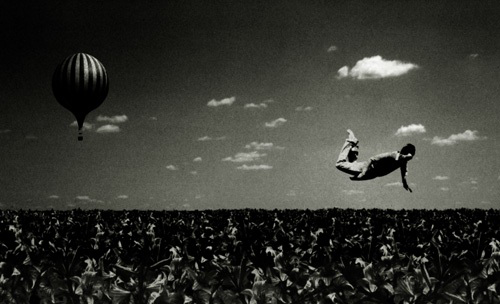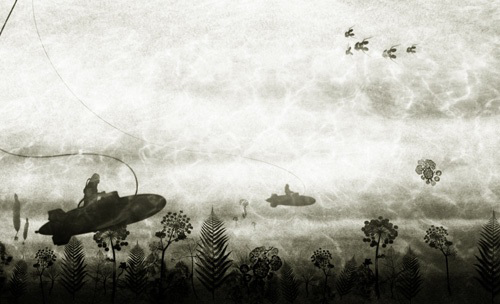7th February – 7th March 2003 :: Berkeley, California
The Kala Art Institute, located on the outskirts of Berkeley, California, is at the epicentre of print-related art practice in the San Francisco Bay Area. Like a semi-permeable cell, it hosts a free-flowing stream of artists from all over the USA, and occasionally, from overseas. Some artists come for a relatively short time before moving on, but just as many come and stay after finding their place in the Kala ‘community’.
Each year, the Kala offers eight Fellowship Awards and Residencies. The Award includes a stipend of $2000 US, and the Residency allows for full use of the institute’s studio facilities for a period of six consecutive months plus free participation in one of their regular workshops. The residency, however, does not include accommodation, and certainly does not cover travel costs, so it is very rarely awarded to artists outside of the USA. In 2002, I was lucky enough to be offered a Fellowship, but due to factors of time, distance and cost, I accepted it with an understanding that my stay would be shorter than the usual expected period of residency.
While my stay was short – only one month, compared to the usual six months’ stint that Fellowship Award winners undertake – in that time I was able to apply myself fully to my work in an environment where the print, as a final object, was of primary concern.
Working primarily with digital imaging, I have tended to see myself as a new media artist, thus I was somewhat surprised to find myself described as a ‘photographer’ when Archana Horsting, co-founder and director of the institute, introduced me to fellow artists upon my arrival. While my work certainly exploits photography through digital manipulation, I have never seen the finished works as photographs, let alone my own practice as being photography. This view, however, underestimated the general level of acceptance that the digital print, as a valid print medium, is rapidly acquiring.
My initial impression was that perhaps the environment of the Kala Art Institute was not one conducive to digital media, as the majority of artists I met there seemed to be working mainly in traditional print media. However, after a few days I soon realised that there was a free flow of practice between the upper floor of the institute, where presses, inks and baths were housed, and the Electronic Media Center (EMC) on the lower floor, home to G3’s, stylus printers and film scanners.

Too Much A Philosopher by Andrew Mamo
Studio-based print artists would frequently bring freshly dried mono-prints, for example, to the EMC, render some detail or texture in PhotoShop or Illustrator, then run their print through the massive Roland printer, fixing the new information to the image, before taking it back up to the studio where linocut, photo-gravure or other kinds of traditional print processes were then worked into it. Others would bring in old, well-worn plates and place them directly onto flat bed scanners, capturing in high-resolution the rich colours and textures of many inkings, then render these abstract surfaces as large-scale inkjet prints on fine watercolour paper.
So it was that in this environment of constant interchange between different types of print media, both analogue and digital, I found myself having to give serious consideration to the final printed form of my images. Having worked and taught in the multimedia field for five years, this was something new for me, as most of my technical considerations had been devoted to the more arcane aspects of screen-based image construction in PhotoShop.
The images I produced during my residency continued a theme I have been mining for some time: the notion of representing alternative histories and alternative evolutionary paths, where the past has accelerated along many routes beyond the present.
This work has focused on what could mainly be called ‘portraits’ in a series tentatively titled Are We Not Men? Through these images, I attempt to revitalise the notion of ‘the prodigy’, or more simply, an empowered notion of ‘the freak’, regaining for human anomalies a pre-scientific status. The portraits are ‘stitched’ together from various sources, mainly anonymous nineteenth portraiture, ethnographic studies, and various photographic curiosities. Process in these pieces is integral to the theme, vaguely referring to the uber-Gothic literary presence of Frankenstein, and the various fakeries presented by the likes of P.T.Barnum. While at Kala, these images literally expanded into broader landscapes that incorporated unspecific narrative scenarios more in the vein of Jules Verne rather than Mary Shelley. I also began to incorporate elements from my own negatives, some more than ten years old.

Black Frost by Andrew Mamo
In printing these images, I worked exclusively with an Epson 7200 Stylus Pro. This printer was a recent acquisition for Kala’s EMC, arriving almost the same day I did. While it is designed to accommodate prints up to 24 inches wide, I found it just as useful for my prints, which were no larger than 11 inches by 17 inches. I experimented with several different types of paper, but eventually settled on Lumijet’s Preservation Series Classic Velour, a coated archival paper that has a suitably warm toned appearance that lends itself to the “archaic” nature of my images.
This experimentation resulted in a total of eight finished prints. These prints will be appearing in a group show, along with the work of other Fellowship winners, at the Kala Institute in July of this year. From these eight prints, Kala will select three to keep in their permanent collection.
The residency at the Kala Art Institute was a useful and enlightening experience, and I would like to thank ANAT for its support. The Conference and Workshop Fund was crucial in assisting me to overcome the costs of the residency that the stipend could not cover.
Tags: analogue and digital print, digital imaging, digital manipulation





